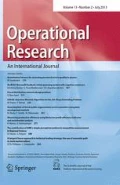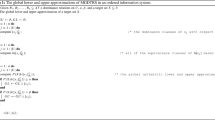Abstract
Geometric programming has been applied in the problems of engineering design, economics and management science. The conventional deterministic geometric programming method requires precise single values for the coefficients and exponents of decision variables. However, there may exist uncertainty and impreciseness about the parameters as well as data in complex real-life problems. In such situations, the deterministic geometric programming method is inappropriate. In this paper, we integrate the deterministic geometric programming with rough set theory to propose a rough geometric programming method. Our proposed method has mainly three characteristics. Firstly, the coefficients in the objective function and constraints are rough variables. Secondly, the expected-value operator of rough variables is implemented. Thirdly, the method can determine both lower and upper bounds of the objective function at a specific trust level. Three illustrative examples are presented to demonstrate the efficacy of our novel method.
Similar content being viewed by others
References
Avriel M, Wilde DJ (1970) Stochastic geometric programming. In: Kuhn H (ed) Proceedings of the princeton symposium on mathematical programming. Princeton University Press, Princeton, pp 73–89
Avriel M, Dembo R, Passy U (1975) Solution of generalized geometric programs. Int J Numer Meth Eng 9:149–168
Beightler CS, Philips DT (1976) Applied geometric programming. Wiley, New York
Boyd S, Vandenberghe L (2004) Convex optimization. Cambridge University Press, Cambridge
Boyd S-J, Patil D, Horowitz M (2005) Digital circuit sizing via geometric programming. Oper Res 53(6):899–932
Boyd SJ, Vandenberghe L, Hossib A (2007) A tutorial on geometric programming. Optim Eng 8(1):67–127
Chiang M (2005) Geometric programming for communication systems. Now Publishers, Boston
Chiang M, Boyd S (2004) Geometric programming duals of channel capacity and rate distortion. IEEE Trans Inf Theory 50(2):245–258
Choi JC, Bricker DL (1996) Effectiveness of a geometric programming algorithm for optimization of machining economics models. Comput Oper Res 10:957–961
Dubois D, Prade H (1990) Rough fuzzy sets and fuzzy rough sets. Int J Gen Syst 17:191–209
Duffin RJ, Peterson EL (1973) Geometric programming with signomials. J Optim Theory Appl 11:3–35
Duffin RJ, Peterson EL, Zener C (1967) Geometric programming: theory and applications. Wiley, New York
Dupačová J (2010) Stochastic geometric programming with an application. Kybernetika 46(3):374–386
Fang SC, Peterson EL, Rajasekera JR (1988) Controlled dual perturbations for posynomial programs. Eur J Oper Res 35:111–117
Hershenson MD, Boyd SP, Lee TH (2001) Optimal design of a CMOS op-amp via geometric programming. IEEE Trans Comput Aided Des Integr Circuits Syst 20:1–21
Hsiung KL, Kim S-J, Boyd S (2005) Power control in lognormal fading wireless channels with optimal probability specifications via robust geometric programming. In: Proceeding IEEE, American control conference, Portland, OR, vol. 6, pp 3955–3959
Islam S (2008) Multi-objective marketing planning inventory model: a geometric programming approach. Appl Math Comput 205:238–246
Jagannathan J (1990) A stochastic geometric programming problem with multiplicative recourse. Oper Res Lett 9:99–104
Jung H, Klein CM (2001) Optimal inventory policies under decreasing cost functions via geometric programming. Eur J Oper Res 132:628–642
Jung H, Klein CM (2006) Optimal inventory policies for profitmaximizing EOQ models under various cost functions. Eur J Oper Res 174:689–705
Khanjani SR, Tavana M, Fukuyama H, Di Caprio D (2015a) Fuzzy chance-constrained geometric programming: the possibility, necessity and credibility approaches. Oper Res: Int J. Accepted for Publication
Khanjani SR, Tavana M, Di Caprio D, Fukuyama H (2015b) Solving geometric programming problems with normal, linear and zigzag uncertainty distributions. J Optim Theory Appl. Accepted for publication
Kortanek KO, No H (1992) A second order affine scaling algorithm for the geometric programming dual with logarithmic barrier. Optimization 23:303–322
Kortanek KO, Xu X, Ye Y (1997) An infeasible interior-point algorithm for solving primal and dual geometric programs. Math Program 76(1997):155–181
Lin MH, Tsai JF (2012) Range reduction techniques for improving computational efficiency in global optimization of signomial geometric programming problems. Eur J Oper Res 216:17–25
Liu B (2002) Theory and practice of uncertain programming, 1st edn. Physica-Verlag, Heidelberg
Liu B (2004) Uncertainty theory: an introduction to its axiomatic foundations. Springer, London
Liu ST (2006a) A geometric programming approach to profit maximization. Appl Math Comput 182:1093–1097
Liu ST (2006b) Posynomial geometric programming with parametric uncertainty. Eur J Oper Res 168:345–353
Liu ST (2007a) Profit maximization with quantity discount: an application of geometric program. Appl Math Comput 190:1723–1729
Liu ST (2007b) Geometric programming with fuzzy parameters in engineering optimization. Int J Approx Reason 46:484–498
Liu ST (2008) Posynomial geometric programming with interval exponents and coefficients. Eur J Oper Res 186:17–27
Liu ST (2011) Fuzzy measures for profit maximization with fuzzy parameters. J Comput Appl Math 236:1333–1342
Maranas CD, Floudas CA (1997) Global optimization in generalized geometric programming. Comput Chem Eng 21(1997):351–369
Nguyen HS (2006) Approximate boolean reasoning: foundations and applications in data mining, transactions on rough sets V, Lecture Notes in Computer Science, 4100, 344–523
Omrani H, Keshavarz M (2014) An interval programming approach for developing economic order quantity model with imprecise exponents and coefficients. Appl Math Model 38:3917–3928
Pawlak Z (1982) Rough sets. Int J Inf Comput Sci 11:341–356
Pawlak Z (2002) Rough set theory and its applications. J Telcommun Inf Technol 3:7–10
Pawlak Z, Skowron A (2007a) Rudiments of rough sets. Inf Sci 177:3–27
Pawlak Z, Skowron A (2007b) Rough sets: some extensions. Inf Sci 177:28–40
Pawlak Z, Skowron A (2007c) Rough sets and Boolean reasoning. Inf Sci 177:41–73
Peterson E (2001) The fundamental relations between geometric programming duality, arametric programming duality and ordinary lagrangian duality. Ann Oper Res 105:109–153
Qian YH, Liang JY, Pedrycz W, Dang CY (2010) Positive approximation: an accelerator for attribute reduction in rough set theory. Artif Intell 174:597–618
Rajgopal J (1992) An alternative approach to the refined duality theory of geometric programming. J Math Anal Appl 167:266–288
Rajgopal J, Bricker DL (1990) Posynomial geometric programming as a special case of semi-infinite linear programming. J Optim Theory Appl 66:455–475
Rajgopal J, Bricker DL (2002) Solving posynomial geometric programming problems via generalized linear programming. Comput Optim Appl 21:95–109
Sadjadi SJ, Hesarsorkh AH, Mohammadi M, Naeini AB (2015) Joint pricing and production management: a geometric programming approach with consideration of cubic production cost function. J Ind Eng Int 11:209–223
Samadi F, Mirzazadeh A, Pedram MM (2012) Fuzzy pricing, marketing and service planning in a fuzzy inventory model: a geometric programming approach. Appl Math Model 37:6683–6694
Scott CH, Jefferson TR (1995) Allocation of resources in project management. Int J Syst Sci 26:413–420
Seong K, Narasimhan R, Cioffi JM (2006) Queue proportional Scheduling via geometric programming in fading broadcast channels. IEEE J Sel Areas Commun 24(8):1593–1602
Tao Z, Xu J (2012) A class of rough multiple objective programming and its application to solid transportation problem. Inf Sci 188:215–235
Tsai JF (2009) Treating free variables in generalized geometric programming problems. Comput Chem Eng 33(1):239–243
Tsai JF, Lin MH (2006) An optimization approach for solving signomial discrete programming problems with free variables. Comput Chem Eng 30:1256–1263
Tsai JF, Lin MH (2011) An efficient global approach for posynomial geometric programming problems. INFORMS J Comput 23(3):483–492
Tsai JF, Lin MH, Hu YC (2007) On generalized geometric programming problems with non-positive variables. Eur J Oper Res 178:10–19
Xu J, Tao Z (2012) Rough multiple objective decision making. CRC Press, New York
Xu J, Li B, Wu D (2009) Rough data envelopment analysis and its application to supply chain performance evaluation. Int J Prod Econ 122:628–638
Yang HH, Bricker DL (1997) Investigation of path-following algorithms for signomial geometric programming problems. Eur J Oper Res 103:230–241
Zadeh LA (1978) Fuzzy sets as a basis for a theory of possibility. Fuzzy Sets Syst 1(1):3–28
Zhu J, Kortanek KO, Huang S (1992) Controlled dual perturbations for central path trajectories in geometric programming. Eur J Oper Res 73:524–531
Acknowledgments
The first author was partially supported by the Grant from the University of Tabriz.
Author information
Authors and Affiliations
Corresponding author
Rights and permissions
About this article
Cite this article
Shiraz, R.K., Fukuyama, H. Integrating geometric programming with rough set theory. Oper Res Int J 18, 1–32 (2018). https://doi.org/10.1007/s12351-016-0250-0
Received:
Revised:
Accepted:
Published:
Issue Date:
DOI: https://doi.org/10.1007/s12351-016-0250-0




